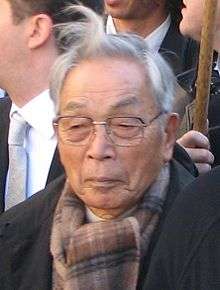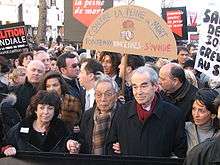Sakae Menda
Sakae Menda (免田栄, Menda Sakae, born November 4, 1925) is a Japanese man who was convicted of a double homicide, in 1948, but was later exonerated by retrial in 1983. This was the first time anyone was ever released from death row by retrial in Japan. He is now a leading figure in Japan for the movement to abolish the death penalty.[1]
Sakae Menda | |
|---|---|
 | |
| Born | November 4, 1925 |
| Occupation | Activist |
| Spouse(s) | Tamae Menda |
Background
On December 30, 1948, an unknown killer broke into the house of a 76-year-old Buddhist priest and his 52-year-old wife in Kumamoto Prefecture on Kyushu and murdered them using an axe and a knife. The killer also wounded their two young daughters, aged 12 and 14. During the same period, Sakae Menda, a poor and uneducated farmhand, was arrested on the charge of stealing rice.[1]
Arrest and trial
Police held Menda for three weeks, without allowing him access to a lawyer, until they extracted a confession. During interrogation, he was starved of food, water and sleep, and beaten with bamboo sticks while being suspended upside down from a ceiling. The police eventually coerced Menda into signing a written statement. He was tried and was convicted of double homicide despite pleading innocent. On March 23, 1950, Judge Haruo Kinoshita sentenced him to death. The Supreme Court of Japan upheld his sentence on December 25, 1951. A lawyer only came to see Menda once before the trial. The lawyer, a Buddhist monk, came to pray for him, but offered no professional expertise to help him fight the charges, but instead told Menda to accept his fate. His trial did not include any physical evidence or the witness accounts that proved Menda had an alibi. He was wrongly convicted of murder and robbery based on the extorted confession.[1][2]
Incarceration
Menda was incarcerated at the Fukuoka Detention Center in solitary confinement. He was held in a 5 square meter unheated cell that was lit day and night and monitored constantly.[1]
Under the Japanese 1907 penal code, death row inmates, unless they are involved in legal appeals, could be taken away for execution at prison gallows at any time, with little notice. Executions in Japan are typically held in secret, and prisoners are either not warned of their impending execution or are notified only on the morning of the day of the execution. Their families are informed later so they can collect the corpse for cremation.[3]
In prison, Menda converted to Christianity and began reading the Bible and transcribing books into Braille.[1]
Retrial
Menda submitted six petitions for retrial although initially he did not have access to a lawyer. The Fukuoka District High Court ruled on the reopening of the case in 1979.
The retrial began on September 27, 1979. The retrial allowed records that proved his alibi to be submitted, as well as a statement from a witness saying that she had lied under duress.
On July 15, 1983, after 80 judges had been involved, the court delivered the verdict of an acquittal based on determination that he had falsely confessed and that the prosecution had failed to disclose exculpatory evidence to Menda's lawyers prior to his trial. The court acknowledged that the police had concealed his alibi showing he was not at the scene of the crime. Menda was released after 34 years on death row at the age of 54. He was the first person in Japan’s history to be released from death row.[4]
Life after release

The government gave Menda 7000 yen for every day he was in prison: 90 million yen in total (approximately 2009 USD $990,540). He donated half of that to a group campaigning to abolish the death penalty.[5] Menda has since become a death-penalty abolitionist. Japan is the only member of the Group of Seven industrialised nations other than the United States to retain capital punishment.[6] Menda spoke at the 2007 World Congress against the death penalty,[1] and has lobbied delegates of the United Nations to globally abolish capital punishment, describing the psychological and dehumanising effects that he encountered while on death row.[7][8] The scandal in the aftermath of Menda's release prompted reform and aided a reintroduction of jury trials in Japan, as well as showing the Japanese legal system's over-reliance on conviction by means of confession.[9][10]
Menda had difficulty claiming his state pension as he had been unable to sign up during his time in prison.[11]
He has continually criticised Japanese execution policy since his release.[12]
Documentary film and book
A documentary movie, Menda Sakae: Gokuchu no Sei (Sakae Menda: A Life in Prison), detailing Sakae's life on death row, was released in 1998.[13] In 2004, Menda released a book, Gokuchu noto (Prison Notes).[1]
See also
References
- McNeill, David; Mason, C. M. (August 4, 2007). "One who has lived to tell the tale". The Japan Times.
- "Free After 12,598 Days". Ocala Star Banner July 16, 1983. p. 1B. Google News. Retrieved March 12, 2014.
- Pilkington, Ed (November 16, 2007). "Three stories of innocents on death row". Taipei Times.
- McGue, Kevin (June 15, 2009). "Hung jury". Japan Today.
- Johnson, David T.; Zimring, Franklin E. (February 2, 2009). The Next Frontier : National Development, Political Change, and the Death Penalty in Asia. Oxford University Press. p. 46. Google Books. Retrieved March 12, 2014.
- "Q&A: 'Confessions Are Not Always True'" Archived 2009-08-08 at the Wayback Machine. Inter Press Service. October 24, 2007.
- Magee, Seana K. (October 19, 2007). "Freed man slams executions of innocent". The Japan Times.
- "Panel Discussion". Amnesty International. 16 October 2007 Economic and Social Council Chamber, United Nations Archived June 25, 2009, at the Wayback Machine
- Rodgers, Paul; Nishimoto, Kyoko (April 19, 2009). "Juries return to Japanese courts after 66 years". Fathers 4 Justice.
- Kiss, Lester W. (1999). "REVIVING THE CRIMINAL JURY IN JAPAN". Duke University School of Law.
- "JAPAN: Man off death row wants pension ". Seniors World Chronicles/The Japan Times. June 4, 2009, Retrieved March 12, 2014.
- French, Howard W. (June 30, 2002). "Secrecy of Japan's Executions Is Criticized as Unduly Cruel". The New York Times.
- "Menda Sakae: Gokuchu no Sei (1998)". The New York Times. Retrieved March 12, 2014.